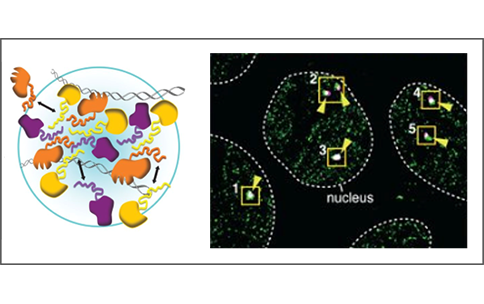
At any given time, only some of the genes in our DNA are turned on, or “active,” while others are turned off. Making sure only the correct genes are turned on in the correct cells is critical for our health. Scientists aim to understand how proteins in cells coordinate to turn a gene on, which could help identify strategies for treating improper regulation of gene activity. Two 4D Nucleome program-funded studies recently published in the journal Science explore the protein interactions that help turn a gene on. Both studies found that proteins cluster together at regions in the DNA called enhancers and interact to trigger gene activation.
In one study, Dr. Ibrahim Cisse and a team of researchers used live-cell super-resolution microscopy to view single molecules of proteins in mouse cells. They were able to view the interactions of a protein complex called Mediator, which helps kick-start transcription, and RNA polymerase II, the protein that carries out transcription by copying DNA into RNA. They found that both Mediator and RNA polymerase II group into stable clusters forming liquid-like droplets, a process known as phase-separation. Protein interactions were found to be brief, with proteins able to move in and out of the droplets, and droplets able to fuse together. They propose that Mediator droplets cluster at enhancers and fuse with RNA polymerase II droplets, allowing interactions between Mediator and RNA polymerase II that spur transcription to turn on genes.
In another study, led by Dr. Robert Tijan and Dr. Xavier Darzacq, the research team used live-cell single-molecule imaging to explore how proteins called transcription factors bind to the DNA enhancer and interact to initiate gene activation. They found that transcription factors also form high-concentration clusters that localize at the enhancer to stabilize DNA binding, recruit RNA polymerase II, and activate transcription. The interactions between transcription factors and RNA Polymerase II were rapid, reversible, and selective, making them a potential class of drug targets for regulating the process of gene activation.
References
- Mediator and RNA polymerase II clusters associate in transcription-dependent condensates. Cho, WK, Spille, JH, Hecht, M, Lee, C, Li, C, Grube, V, and Cisse, II. Science. 361, 412-415. 2018 July 27.
- Imaging dynamic and selective low-complexity domain interactions that control gene transcription. Chong, S, Dugast-Darzacq, C, Liu, Z, Dong, P, Dailey, GM, Cattoglio, C, Heckert, A, Banala, S, Lavis, L, Darzacq, X, and Tijan, R. Science. 361 (6400). 2018 July 27.
In the News
- It may take a village (of proteins) to turn on genes,Science News


